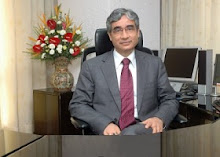•June 2007, as RM, Almora region – Uttaranchal
•Hilly area, mainly agri-based lifestyle of a largely rural farming population The Initial State •The land was very fertile and the climate well-suited for floriculture. But the farmers had no market access for flowers.
•So, the farmers grew mostly ginger and potato because these crops have a larger shelf life than flowers.
•Even these crops were sold at throwaway prices (Ginger sold @Rs 10/kg, market price in the cities was approximately Rs 100 per kg)
•Farmers were mostly BPL, with no access to education
•Small land holdings
•Dependent on money lenders, borrowed @5%p.m. (approx 60%p.a.)
•Main markets for flowers: Nainital, Dehradun, Ranikhet, Delhi
•Market Price in Almora: Re1/flower The Proposed Solution •In 6-7 villages (out of the 7100 in the region), Mr Kharbanda personally went and introduced the idea of land pooling through SHGs to the farmers.
•The farmers could combine in groups of 10-20, save money as a group, get a loan from the bank as a group and invest it in floriculture (or any other activity they choose)
•Loan money to be used to buy a lorry to transport the flowers to Delhi
•Tie-ups with traders in Delhi through the bankers’ personal contacts
•Other activities: Knitting, basket making, almond growing, pickles etc

Realized End State Customer Wins: •Started floriculture, bought a tempo for transportation to the cities
•90% SHGs comprised women
•Made as much as Rs 10/flower.
•SBI adopted some villages – infrastructure development, education etc
•Participated in exhibitions
•Standard of living rose
•Children sent for education
•New methods of farming soon put in place to further increase yield
Bank Wins:
•The villagers start seeing SBI as an institution that really cares for their development
•95-100% repayment of loans given to SHGs as opposed to around 5% for Government sponsored schemes usually
•43% advances growth (25% in 2006)
•32% growth in deposits (25% in 2006)
•22% Profit growth (20% in 2006)
•Some other benefits would come later, which cannot be measured quantifiably Sustainability Dynamic •Regular monthly meetings were conducted by the branch staff with the SHGs in the villages
•NGOs pulled in to give more information to the bankers about the villagers’ lifestyle, landholding patterns, common income-generating activities, leaders etc
•Mr Kharbanda made status updates on the SHG front a part of the monthly agenda





An excellent job done by one banker who changed the life style and thinking of poor villagers. Why not other follows including the NGOs who are working for the same cause. Keep it up Mr. Kharbanda and SBI
ReplyDelete